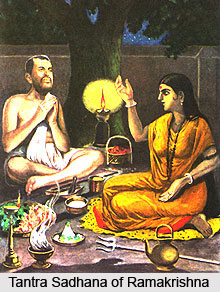 Ramakrishna, at his sojourn in Dakshineswar, came across Bhairavi Brahmani whose actual name was Yogeswari. Any information related to her personal life was unknown. She read the Hindu scriptures and acquired knowledge and also dexterous in Tantric practices and Vaishnava method of worship. Ramkrishna , at that time was experiencing the frequent unconsciousness and idiosyncrasies which according to some of his kith and kins was a serious phase of lunacy. This state of lunacy was well defined by Bhairavi as "mahavaba" which had been experienced by Radha and Chaitanya( the great religious figures). She ushered him in Tantric practices and gradually Ramakrishna got acquainted with the pros and cons of tantra and mastered sixty four major tantric sadhanas. Beginning with mantras followed by japa and purascarana Ramkrishna learned to lead his mind towards transcendence through Tantric practice. Including a set of iconoclastic practices called "Vamachara" which means left hand path and can be defined as a practice which is associated with the "Pancha makara" or the "Five Ms", also known as "Pancha tattva". Literally they represent Madya (wine), Mansa (meat), Matsya (fish), Mudra (money) and Maithuna (sexual intercourse). Vamachara tradition determines strict ritual limits on the use of these literal forms and warm against
nonsanctioned use.
Ramakrishna, at his sojourn in Dakshineswar, came across Bhairavi Brahmani whose actual name was Yogeswari. Any information related to her personal life was unknown. She read the Hindu scriptures and acquired knowledge and also dexterous in Tantric practices and Vaishnava method of worship. Ramkrishna , at that time was experiencing the frequent unconsciousness and idiosyncrasies which according to some of his kith and kins was a serious phase of lunacy. This state of lunacy was well defined by Bhairavi as "mahavaba" which had been experienced by Radha and Chaitanya( the great religious figures). She ushered him in Tantric practices and gradually Ramakrishna got acquainted with the pros and cons of tantra and mastered sixty four major tantric sadhanas. Beginning with mantras followed by japa and purascarana Ramkrishna learned to lead his mind towards transcendence through Tantric practice. Including a set of iconoclastic practices called "Vamachara" which means left hand path and can be defined as a practice which is associated with the "Pancha makara" or the "Five Ms", also known as "Pancha tattva". Literally they represent Madya (wine), Mansa (meat), Matsya (fish), Mudra (money) and Maithuna (sexual intercourse). Vamachara tradition determines strict ritual limits on the use of these literal forms and warm against
nonsanctioned use.
Despite being a devoted seeker of spiritualism, Ramakrishna did not follow the two activities (wine and sexual intercourse) described in "Vamachara" practice. Although Ramakrishna considered "Vamachara" as a way of achieving spiritual nirvana, he did not advocate to anybody. He thought it as an arduous means and can often cause downfall of the aspirant.
Ramakrishna learned the ritual of "Kumari puja"(i.e. a ritual where a virgin girl is worshipped considering God ) from Bhairavi and being her apprentice mastered Kundalini Yoga through which the communication of body and mind is established by meditative and physical disciplines giving special consideration to the role of spine and endocrine system. Bhairavi was affectionate to Ramakrishna and after knowing about the spiritual phenomena in his life considered him as an "Avataar" or incarnation of God.




















